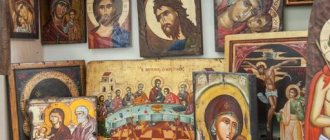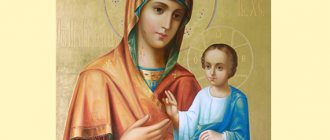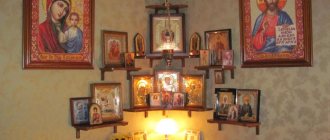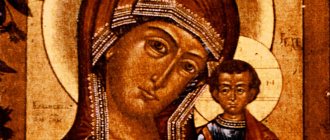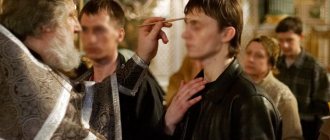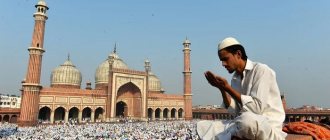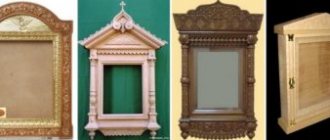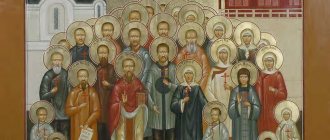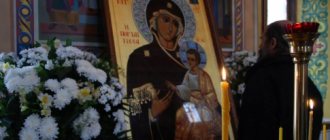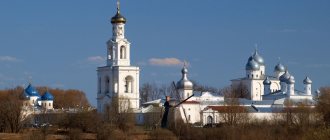Rules for depicting saints
The main method of arranging figures on Orthodox icons is a frontal turn of the main characters. If they are turned towards each other, then the faces are still turned three-quarters towards the person looking at the image. Minor and negative characters are depicted in profile.
The canonical rules depend on the character in the image's plot.
There are image canons:
- Christ;
- Mother of God;
- angels;
- saints;
- holidays.
The strictest regulations concerned Jesus Christ. He could be depicted alone or surrounded by saints.
His appearance must correspond to the biblical description:
- middle-aged;
- dark-haired;
- with a small beard;
- majestic appearance;
- the right hand is raised in a blessing gesture.
Images can be:
- heads;
- to the shoulders;
- to the waist;
- in full height.
The letters I.H. should be written to the right and left of the head of Jesus Christ. The halo is crossed out with a cross, as a reminder of the sacrifice for the human race.
The iconography of the appearance of the Mother of God is more diverse than that of the Son of God. The set of types of images of the Virgin Mary is grouped into 8 subjects, differing in composition and in terms of characters.
Types of Mother of God icons:
- in full height with raised arms and a baby on his chest (Oranta);
- with a baby in his arms who holds a scroll and blesses (Hodegetria);
- without the Son, next to the Archangel Gabriel (Annunciation);
- Mother and Son touch cheeks (Eleusa);
- sits on the throne with the Son (Panahranta);
- Mother breastfeeds her Son (Mammal);
- The Virgin Mary with the adult Jesus and John the Baptist (Deesis);
- lies on the bed, next to the 12 apostles, above the head of Jesus Christ (Assumption);
- single (portrait).
According to the canons, the image of the Mother of God is recognizable on all icons:
- elongated oval face;
- almond-shaped eyes;
- arched eyebrows;
- straight, thin nose;
- small mouth.
The Mother of God's clothing is a tunic, a veil that covers the head and shoulders.
Predominant colors:
- shades of red;
- shades of blue;
- violet;
- gold.
Regarding the image of the Holy Trinity, the icon of the same name by A. Rublev is considered canonical. The description of angels, archangels, cherubim, seraphim must correspond to biblical texts. These are God's Creatures with wings, most often dressed in snow-white chitons and cloaks, or in military armor (Archangel Michael). Each one holds his own attribute in his hands: a sword, a rod, a mirror. All Ethereal Supreme Powers have a halo above their heads.
Saints are depicted on icons if it is known what they looked like during their lifetime, with elements of portrait resemblance. The plot reflects the main essence of their service to the Lord.
Catalog of icons on the website PravIcon.com
Important: I am not a priest, and this text is my personal opinion. If you have an icon whose canonicity you doubt, you should contact your spiritual superior.
Recently, new icons of the Mother of God are increasingly appearing, painted not according to the canons and rejected by some ministers of the Orthodox Church. Many of these icons stream myrrh and give people healing, to which the church responds that these miracles can be revealed not by the Mother of God, but by the Devil, and that the faith of a true Christian should not be based on the expectation of miracles. I don't feel morally right to participate in this debate because from the many pro and con articles I found on the Internet, I couldn't make a definite decision.
Of course, being an Orthodox person, I cannot ignore the opinions of respected Orthodox ministers, and indeed, many “miracles” and visions were performed by devilish forces under the guise of saints. It is quite possible that many new icons of the Virgin Mary were actually painted based on false visions. I in no way encourage icons of Lenin with a halo on the head, etc. Many articles on this subject can be found on the Internet.
But what is the probability that out of a dozen icons created for the deliberate destruction of Orthodoxy, there will not be one or two that were actually revealed at the behest of the Mother of God, although they do not correspond to the classical canons? The arguments that I came across sometimes reached the point of absurdity: they say that if the Mother of God on the icon is in a white robe, and not in red and blue, as it should be according to the canon, then this icon is a false icon. Well, think for yourself, who can forbid the Most Good and Most Pure Virgin Mary to appear before people in a white robe!? You cannot simply blindly reject all icons that do not correspond to the established traditions of the icon painting school. And in this respect, respected ministers of the church can be blinded by the devil’s power, just like those who paint icons displeasing to God. Because of this blind obsession, it seems that they are trying to destroy Orthodoxy not only from the outside, but also from the inside. Just remember the birth of Christianity, when the then guardians of the faith “made a mistake” and crucified the Savior himself on the cross. If in those days everyone had blindly followed the words of priests besotted by the Devil, then Christianity would not have arisen at all! Remember how the Kazan Icon was revealed, how the Mother of God appeared to the ordinary nine-year-old girl Matrona, whom no one believed at all, and if she herself had not shown persistence, would this wonderful icon be with us now? I imagined what would happen if the real Mother of God found it necessary to convey some information to us. How could she do this, if not by her appearance and the miracles emanating from her icons? If you read all the descriptions of revered canonical icons in the pravicon.com catalog, you will find out how many truly miraculous ancient icons were revealed on the basis of visions not to kings, not to patriarchs, but to ordinary believers. If the highest church authorities would then treat these icons with disdain and call them “false icons,” then what would the Mother of God say to this? Maybe “those who have eyes do not see, those who have ears do not hear”?
I repeat once again that I fully support the Orthodox Church, but I also urge people to be vigilant, because everyone has their own path to salvation. And if a non-canonical icon depicts the Mother of God, and there is nothing alien to God in this image, and there is nothing on it that discredits the holiness of the Mother of God, and if prayers in front of this icon give you grace and healing, then I believe that this grace comes from the Mother of God, and I see no reason to believe that it can come from the Devil, as some believe. Even if some icons of the Mother of God were indeed painted with evil intentions, then there is nothing that would prevent the Mother of God from using these images for the benefit of true believers.
Although there is a lot of debate about false icons on the Internet, it’s funny, but I have never found anywhere a list of icons rejected by the Orthodox Church. Therefore, here I have compiled a list of icons of the Mother of God that the Orthodox community speaks unkindly about on the Internet. If you know of other similar icons, write to me indicating the source of information, and I will add them to the list.
And I remind you once again that it is not a fact that these icons are from the evil one, it’s just that the Orthodox Church, represented by certain individuals, currently does not bless people to pray in front of them for various reasons. The surest way not to make a mistake is to pray only in front of those icons that are mentioned in the Orthodox Calendar.
Resurrecting Rus'
. This icon is considered a “false icon” due to dubious (unreliable) visions of the Virgin Mary and unconventional iconography. They even say that the myrrh-streaming, miracles and healings revealed by this icon come from the Devil! The Orthodox Church does not openly support this icon. This icon caused the most fuss about false icons. Look for many opinions on the Internet.
Giver of gifts
.
Due to the fact that “ the Mother of God is depicted in bishop’s vestments with the Eucharistic cup in her hands - that is, as a “priest,” or rather “bishop,” and Orthodox Christianity does not recognize women priests
.” Also, someone did not like the image of Hosts* blessing the Mother of God from heaven. The official opinion of the Orthodox Church is unknown.
Moscow and All Rus'
.
I don’t understand exactly what this icon is being accused of, it seems like “ ...this icon is non-canonical, its image includes symbolism that is not inherent in the icons of the Mother of God
.” The official opinion of the Orthodox Church is unknown.
Autocratic
.
There are two similar icons - “Autocratic” and “Like an eagle’s wings”. I have not found any official statements from the Orthodox Church on this matter, but there are people online who like to criticize these icons. According to some, these icons propagate the advent of a new tsarist Russia
, while others saw in the icon some
Kabbalistic signs
in the form of a two-headed eagle.
Holy Trinity with the Virgin Mary
. I have not seen any comments from the Orthodox Church about this icon, but some consider the icon to be heresy because of its depiction of Hosts* as an old man. I also saw the opinion that the depiction of the Mother of God as part of the Holy Trinity makes her a “goddess” - in general, some kind of nonsense.
Appearance of the Mother of God to Schema-nun Anthony
.
The very appearance of the Mother of God is called into question. In particular, the church rejects the rules that the Mother of God allegedly gave to beg for the sin of abortion: in such “rules” there is a substitution of concepts: instead of repentance for a grave mortal sin, “begging for babies” is proposed
.
But here is a different opinion from the Internet: “ I am against any deviation from the purity of Orthodoxy and, in particular, ritual studies.
But I want to say in defense of Mother Antonia: she did not have any specific rule about babies killed in the womb. And the fact that she prayed about it is true. And she did not have any abortions. And her prayer was solely out of love for people. By the way, the Orthodox Church calls for prayer for babies who died in the womb .
Elena
.". For those who need it, look for debates on this topic on the Internet, there are a lot of flames about this.
Like an eagle's wings
(see Autocratic).
——————- * Image of Hosts on icons. Orthodox icons are not characterized by the depiction of God the Father as a humanoid elder. “ The image of the God of Hosts is non-canonical, and was rejected at the Great Moscow Council of 1665
". In fact, there are many revered miraculous icons depicting the God of Hosts, for example, “The Nativity of the Most Holy Theotokos of Glinskaya,” miraculously revealed in the 16th century, so it would be absurd to call an icon a false icon only on the basis that it depicts the God of Hosts in the form old man More recently, in 2009, with the blessing of His Holiness Patriarch Alexy II of Moscow and All Rus', the celebration in honor of the icon of the Mother of God, the Triumph of the Most Holy Theotokos, was included in the monthly calendar of the official calendar of the Russian Orthodox Church, although at the very top it depicts none other than the God of Hosts! It is also interesting that when creating modern iconostases for churches instead of those destroyed during the Soviet years, at the very top they often depict God the Father in the form of an old man, and no one really cares about this, despite the prohibitions, and if in a church this is possible on iconostases draw, then what else is there to talk about...
This article is provided for information only and in no way calls for the creation or distribution of icons that are not officially supported by the church, nor does it call for the desecration or destruction of these icons.
Anatoly, PS: I will not respond to letters whose purpose is to flame on the topic of false icons.
Color palette
The rules for using colors reflect Divine wisdom. Each color has its place and purpose. In canonical icon painting, colors were never mixed, but were superimposed on one another. This method allows you to obtain the desired color shade. To achieve an unearthly effect, colored draperies are highlighted with a different color.
The main color on the icons is gold, a symbol of the Kingdom of Heaven, eternity and grace. Often used as a background. For budget options, ocher and ocher-yellow colors were used. The clothes of the Mother of God, Jesus Christ, saints, wings of angels, gospels, halos over the heads of saints are painted in gold.
White and silver color mean purity, holiness, evangelical eloquence. The righteous and saints wear white robes.
Blue is the color of infinity, a symbol of the desire for God, wisdom and revelation. Jesus Christ and the apostles are dressed in robes of this color. Blue is a symbol of heavenly purity, the color of the Virgin Mary. The background of icons is blue. In accordance with the canon, the clothes of the Mother of God are supposed to be painted in blue or burgundy.
The red tone of the color scheme is found in images more often than others, as an emitter of life-giving energy and love. But it is also the color of blood, which is associated with torment. Therefore, red is both a symbol of the Resurrection and a symbol of suffering and horror. The red background of the icons can mean the triumph of victory over death and pictures of hell. Shades of red, burgundy and crimson, are used in icon painting to color the robes of the Savior, the Mother of God, and holy earthly rulers.
The vines, herbs, and leaves are painted in a green tone on the images. It means victory over death, eternal life, it is a sign of the Holy Spirit.
The earth, mountains, and robes of desert saints are painted in a brown tone on the icons. This is the color of humility, renunciation of worldly things, the frailty of human life. The color black is used least often in icon painting; gray is not used at all. Graves, hell, caves are painted black (a symbol of evil and death). The gray tone, obtained from mixing black and white, evil and good, means uncertainty, non-existence.
Be like children?
Icons with non-canonical subjects: on the left – “Peruvian”, on the right – “Mother of Humility”.
Photo: https://ortodoxshop.ru/, https://pravoslavie.ru/ Nowadays, artists who deal with religious art have many extremely different quests - here is the search for a plot, and the search for style, and means of expression, and new materials... This is understandable, since life itself is constantly changing. But the religious, the sacred requires special caution, since here comes contact with the spiritual world.
Nowadays it is fashionable to turn to primitive art. Recently I saw in one church at a hospital such an attempt to fake childishness. The authors have an argument: they say, the Lord Himself said: “Be like children.”
But the Lord also said: do not be children in mind, that is, be like children in passions, since children do not yet know vices - this is what Scripture says. And to draw an icon, the mind needs to be developed.
In ancient times, icon painters were sometimes called "philosophers" because they created wise art. It was wise in its spirituality. It seems to me that modern primitivists have a longing for spirituality and they often look for it in children's art; but they don’t understand what spirituality is, because they don’t know what the holy fathers teach and how the ancient icon painters thought, looking for ways to communicate with the Lord.
Adults cannot dress in children's pants. This is the wrong way. Personally, I believe that any “pseudo” is unacceptable in church painting. By the way, children themselves usually strive to draw “correctly”, like adults, they just can’t do it yet.
The pinnacles of medieval icon painting that we admire today are where icon painters followed traditions dating back to the highly refined art of the ancient Greeks and Romans. Even the most “primitive” medieval icon painter had professionalism: he understood that he was depicting eternity and that special techniques were needed, which he constantly worked on mastering.
Look at the so-called Our Lady of Peru. This image of a woman with a child can, if you like, be called “Madonna” (in Western art this word can mean a variety of contents), but this cannot be called the Virgin Mary!
A simple plot is used here: a young poor woman carries a sleeping baby in a knapsack. To get away from everyday life and achieve monumentalization, the author highlights the background, crops the figure, makes it relatively flat, and uses large rapport (repetition of ornamental forms). The woman’s hands are not depicted, perhaps again for the sake of giving monumentality, but the depicted hand of a child takes on the character of a sign, and this is even interesting as a device.
Silhouette and some idealization of faces are taken here from icon painting. The author has a good sense of the ornamental principle in the icon: he composed a variety of motifs that combine well and give the image a festive feel, but there is not a single Christian ornamental motif here. All this is not bad at all as painting in general, but what does the Christian name have to do with it?
According to the decisions of the Seventh Ecumenical Council, the image is revered on an equal basis with the word. And therefore it must necessarily be correlated with the word, that is, with the text. In truly Christian art, literally every stroke is associated with a general meaning and may even be a special sign.
The author of this composition stylizes the pretty face of a young woman who is happy with her peacefully sleeping baby. She is, one might say, “everything is fine.” Both sensual lips and calm eyes speak about this. This has nothing to do with the gospel image of the Most Pure Virgin.
The image of the Virgin Mother is a “super task” for art, since we are talking about a completely unprecedented, impossible and unthinkable birth of the God-Man. To depict this, we need faith - that is, an assumption of the impossible that is significant for our entire life and turns everything upside down in it. If you are unable to believe in the impossible, then you will never create a convincing image of the impossible. Better not even bother with it.
Perspective
Orthodox icon painters abandoned linear perspective, maintaining the tradition of reverse perspective. The rationale is the thesis that an icon is not a painting. The icon painter depicts something that no one has seen. The embodiment of the image depends on its spiritual state, not “carnal” but “spiritual” vision. The use of reverse perspective allows you to expand and deepen the image, bringing the icon closer to the religious content of the plot embodied on the board or fresco.
With direct perspective, the lines converge in the depth of the image plane. In the case of the reverse, the lines converge outside the image, which emphasizes the unearthly essence of what is happening to the characters in the icon, showing the grace overshadowing the earthly world from the heavenly world. Thanks to the technique of reverse perspective, the window into the sacred world opens wider. The space not from the earthly world on the icons is indicated by a golden background, and objects, their relative positions, are given in reverse perspective.
Why are handwritten icons valued?
Handwritten (aka handwritten) icons are valued for their craftsmanship and individual handcraft. First, the icon painter creates a drawing on paper, and then transfers it to a board made of special types of wood.
Traditionally, icon boards were made from alder, linden, cypress, conifers: pine, spruce, larch, and in the southern regions - from beech. Nowadays, linden is the most popular because its wood is soft and light, and does not deform over time.
The board is covered with a special ground layer - gesso, which is chalk mixed with animal or fish glue. The icon painter applies a drawing to this layer with a thin brush and only then begins to paint all the elements with tempera paints. The more figures there are in the composition of an icon, the more labor-intensive the process of painting it is.
Non-canonical
Catholic icons are not canonical. These are paintings on religious themes. Western icon painting is characterized by the use of direct perspective. Images of Jesus Christ, the Mother of God, and saints are devoid of convention. Believers see them in their familiar human form. Color has no symbolic meaning. The Catholic icon has an emotional connotation and reflects the author’s worldview.
How to depict eternity?
What is eternity expressed in? You won’t say that the eternal is something crooked, slanted, meaningless. Eternity in church art is expressed in special signs, but above all - in the piety of the image. The image must be pious, and for this you need to live like a Christian. If you want to write for the Church, contact experienced confessors who will teach you to understand what piety is.
For an icon painter, purity of heart is needed, about which it is said: “Blessed are those who are pure in heart, for they will see God.” We cannot see eternity, but we know it with our hearts. Therefore, the task of the icon painter is in some way prophetic. And this is very important.
Look at any traditional icons. You will see that this eternity is there. A specialist can point out the methods by which this is achieved: there is no or almost no texture of the material on the icons, there is no heaviness of large, voluminous objects. All this is “cancelled” in icon painting in order to show the intangible essence of the image. This is science, and theology, and art.
Let's look at a modern icon called “Mother of Humility”. The creator of this work collected various iconographic elements: here is a mandorla in three tones, and a throne, and two cherubs, and “we will fall”, and halos, and an ark... And, it would seem, such a touching cry of Christ (or a groan? or a dream? or...) on the knees of His Mother... Why not an icon?
A very strange image. Firstly, if you use a set of certain signs, then you need to follow the rules for their use - correlation, placement, arrangement. The medieval sign system always follows strict rhythm and symmetry (by the way, there are different symmetries). The throne composition is always in the center. This is required by the royalty of the image. And here the artist has shifted the main images from the central axis. What's the point of this? It simply results in a loss of balance. But the main thing is not even the location, but the content of the composition itself.
Where is the humility here? What's this about? Do we know what humility is? An adult man sobbing on his mother’s lap, excuse me, even looking like the Savior, does not at all correspond to Jesus Christ of the Orthodox Tradition. Where, what canonical text confirms such a sentimental construction?
You may say: “We are artists, we are free people, what do we care about your canonical texts!” Well, in that case there's really nothing to talk about. In my opinion, from such “freedom” art does not become more ecclesiastical and spiritual, but becomes a sign of one’s own pride, which moves contrary to tradition and canon.
Is novelty necessary in icon painting?
Icons with non-canonical subjects: on the left – “First Steps”, on the right – “Peter at the Fire”.
Photo: https://ortodoxshop.ru/ Don’t confuse new and “new”. “New” usually aims to engage, entertain, and gather an audience. But the Church is not an exhibition hall or a theater, it is a holy place. The new appears there as a miracle, as a revelation, as an inspiration, which arises not for the public’s needs, but according to the inner intuition of a master immersed in eternity.
To depict the Holy Trinity in a new way, you need to have a vision of the Holy Trinity - no more and no less, as was the case with the Monk Andrei Rublev.
New things most often appear as a response to the movement of church history. For example, in the twentieth century many new martyrs appeared. Each time it is a new personality, a new situation that requires comprehension. Let us recall, as a striking example, the iconography of the Royal Passion-Bearers - the image of the last emperor with his wife and children. This is a completely new and very significant theme of modern church art.
But if you try “from the wind of your head” to compose something original in order to receive some kind of award or recognition for it, this is strange, absurd and essentially of no use to anyone.
An example is the composition “First Steps”. This is a claim to new iconography, since the first steps of the Mother of God were previously depicted (the icon “The Entry of the Mother of God into the Temple - editor’s note), but not the Savior. The Church has always observed special caution regarding any images of the Lord Jesus Christ. In particular, there was a rule according to which any image was possible only if there was at least someone who saw the event (or person) being depicted. There must be at least apocrypha.
But no one saw the infancy of Christ, his first steps were not mentioned anywhere. That is, such an image is a figment of fantasy. But fantasy is daydreaming; a dream is an illusion that has nothing to do with spiritual experience. And spiritual experience is true knowledge of oneself through deep cleansing of the heart and mind. Only then is spiritual vision gained, allowing one to at least partially understand the higher world.
In the matter of recognition of new iconography, it is desirable that difficult cases be resolved by the conciliar consciousness of the Church. We need a permanent commission of high professionals, representatives of the clergy, theologians, which will consider new ideas in church art. This commission could make recommendatory decisions, which over time would receive approbation by the Church.
An icon painter needs a “conscience for things”
It is unacceptable for an icon painter to paint some sinful, unbridled pictures parallel to the icons. There is a special resolution of the Fifth-Sixth (Trullo) Council, which states that a church artist who dares to create seductive images that produce an “explosion of unclean pleasures” is excommunicated from communion.
An icon painter needs, in the words of Avva Dorotheus, “a conscience for things,” for those icons that he dares to paint. And conscience requires constant cleansing.
Nowadays, icons are predominantly studied by art historians, who understand icons purely as works of art. Orthodox art experts tie the study of icons to church life and history. But it is very important that the theology of the icon develops, an understanding of how this or that theological idea finds expression in the image.
When the understanding of iconographic techniques as a special theological language is more deeply developed, it will be easier to assess the acceptability of one or another iconographic image.
